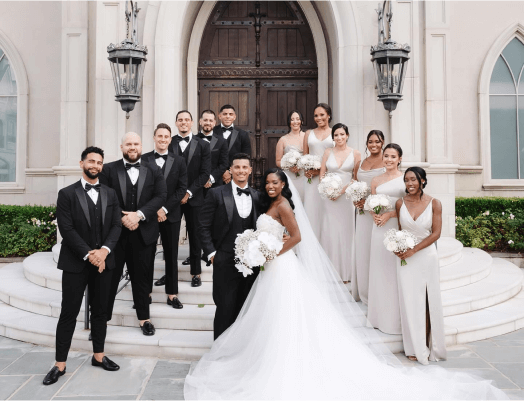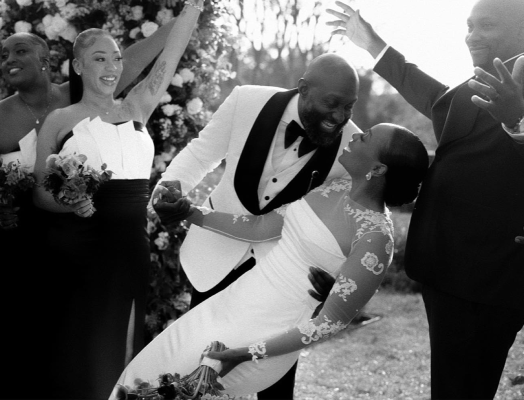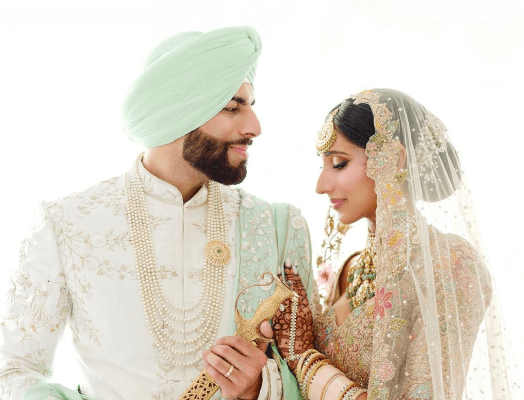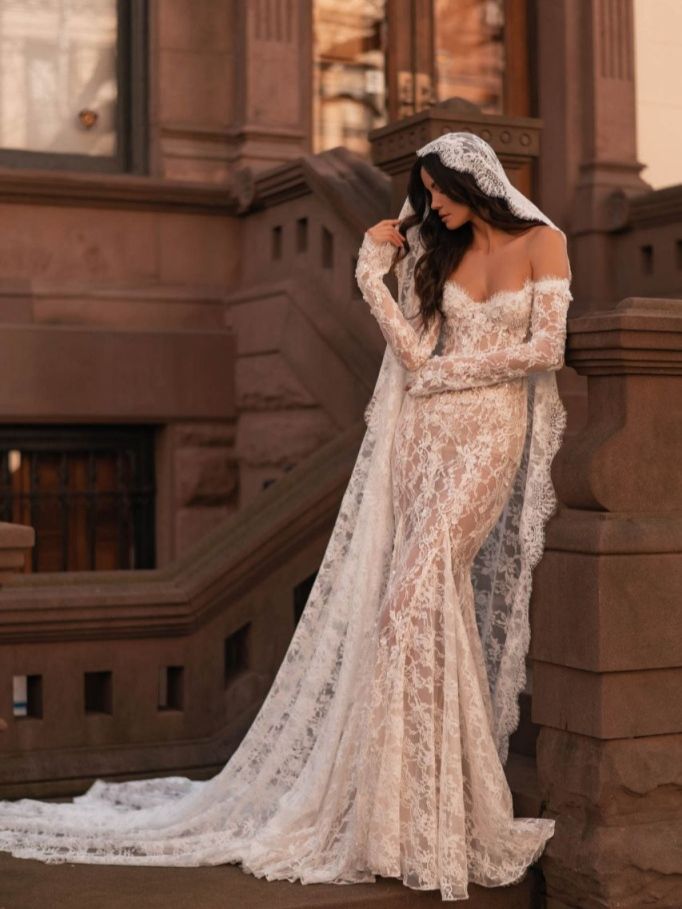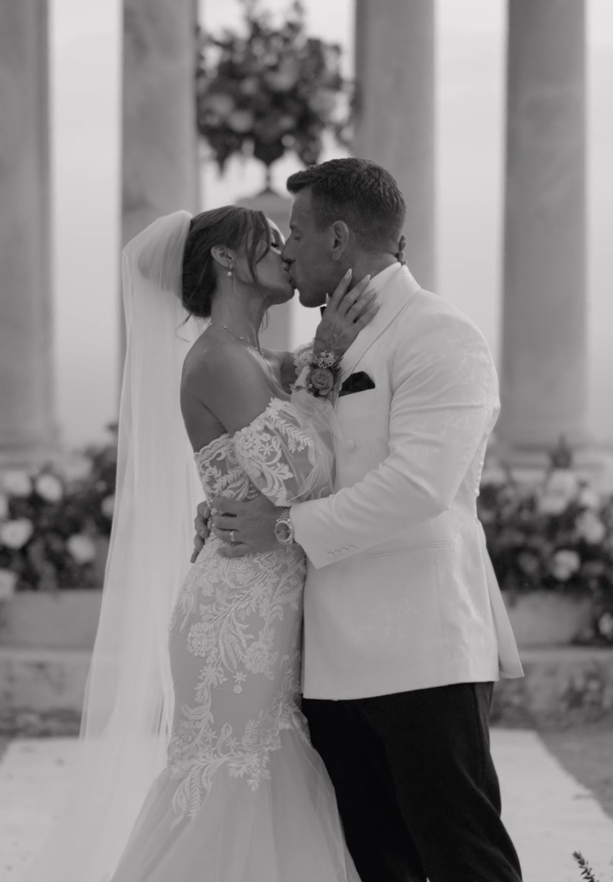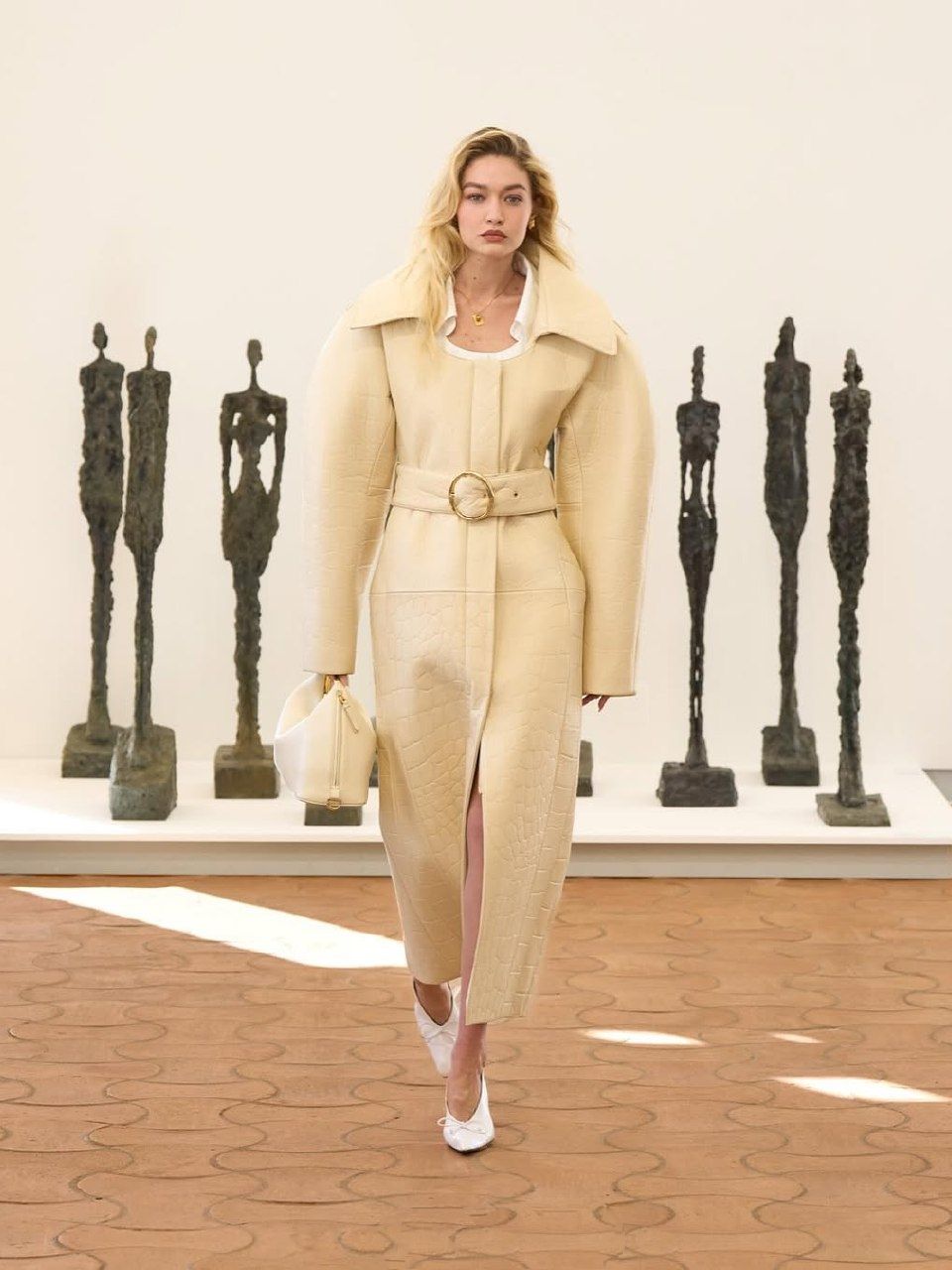Your Huge Wedding Etiquette Guide
- Author: Natali Grace Levine
- Reading time: 17 min 55 sec
- Publication date: 04/08/2025
- Updated: 08/21/2025
Picture this: it's 2:00 a.m., your mind is racing with thoughts of florals versus greenery, invitation wording conundrums, and a future mother-in-law who’s convinced the napkins must match her favorite shade of mauve. Meanwhile, you’re frantically scrolling through blogs and social media, trying to figure out what the heck “casual elegance” actually means. If this sounds familiar, congratulations—you’re neck-deep in wedding planning. But fear not! This wedding etiquette guide is here to help you surf the chaos with style and sanity.
We’ll skip the dusty, archaic “rules” and get straight to the gems of modern wedding etiquette. Why? Because today’s weddings aren’t one-size-fits-all, and neither is your love story. You deserve honest, clear advice that respects your individuality and helps you steer those essential details—everything from invitations and dress codes to wrangling the wedding party and keeping your Great Aunt Madeline happy (or at least not outraged). By blending tradition with contemporary twists, you’ll keep things meaningful yet forward-thinking, formal yet totally you.




Find Your Perfect Wedding Vendors
Setting the Stage: Modern Wedding Etiquette
Weddings today are as diverse and dynamic as the couples who plan them. From sweeping ballrooms to backyard ceremonies, the possibilities are endless. In all this variety, modern etiquette acts like a friendly compass, offering thoughtful guidelines instead of rigid mandates. Understanding how to weave these gentle principles into your day will help you create a celebration that’s inviting, respectful, and distinctly yours.
Why Etiquette Matters
Etiquette isn’t about being stuck in the past. Rather, it’s about fostering clear communication and genuine warmth, so that every individual involved—your guests, vendors, and especially you—feels valued and respected. By embracing these principles, you’ll likely see smoother interactions with family members, a more relaxed wedding party, and fewer misunderstandings over attire or schedules. Etiquette also encourages a certain graciousness that can elevate the overall mood, turning even minor moments into opportunities for connection and joy. When you approach your wedding with this mindset, you’re setting the stage for a heartfelt gathering that flows effortlessly and makes everyone feel genuinely welcomed.
Blending Tradition with Personal Style
Many couples wrestle with the decision of which traditions to keep and which to adjust or leave behind. There’s beauty in time-honored rituals—like sharing a first dance or incorporating family heirlooms—that can infuse the event with a sense of continuity. At the same time, modern weddings often include signature twists that reflect the couple’s personalities, such as inventive unity ceremonies or playful guest activities. Etiquette becomes a guiding framework here, helping you maintain cohesion even as you introduce fresh ideas.




Invitations & RSVPs
Planning your invitations and managing RSVPs is like setting the stage for your entire celebration. It’s your big reveal, the moment you let your guests know when and where the magic happens—and what to expect in terms of style and tone. For many brides, the invitation phase can be riddled with questions: How early is too early to send out save-the-dates? What if we want a specific dress code? How do we politely handle guests who haven’t RSVP’d on time? Read on.
Timing & Strategy
Even in the digital age, invitations still carry a certain ceremonial weight. They mark the first official announcement of your wedding details, so it’s important to plan their release thoughtfully. If you’re hosting a local wedding during a typical season, sending invitations six to eight weeks beforehand usually works just fine. But for destination events or peak travel dates, consider sending save-the-dates six to eight months in advance, followed by formal invites at least three months ahead of time.
A few key points to keep in mind:
- Save-the-Date Cards: Let guests pencil your wedding into their schedules early on, especially if many will be traveling.
- Invitation Mail-Outs: Aim for a window that gives guests plenty of response time. Too early and people lose track; too late and they struggle to make arrangements.
- Digital vs. Print: Classic paper invitations exude timeless elegance, but e-invites can be convenient, budget-friendly, and eco-conscious. Choose what aligns with your style and resources.
Wording & Clarity
The wording on your invitations sets the tone for the day—formal, casual, whimsical, or somewhere in between. Whether you’re honoring tradition or forging your own path, clarity is crucial. You want guests to quickly gather the event’s essentials without feeling overwhelmed or confused.
Consider these guidelines for a polished look:
- Names & Titles: Include both sets of parents (if they’re hosting) or simply the names of the couple. Keep titles consistent if you’re going traditional (“Mr. and Mrs. Smith request the honor of your presence”).
- Date, Time & Location: Make sure these details are straightforward. If your reception is at a different venue, clearly indicate where and when guests should head there.
- Dress Code: If you have a specific dress code—whether “black tie” or “casual garden party”—it’s best to note that on the invitation or an enclosure card.
- Wedding Website: If you’re using one, provide the link. This is where you can elaborate on directions, accommodations, and day-of logistics.
Handling RSVPs
Gathering responses can feel like herding cats. Some guests reply right away; others set the card aside and forget about it. Establishing a plan for RSVPs helps you stay organized and maintain your sanity.
Tips for a smooth RSVP process:
- Set a Clear Deadline: Two to three weeks before you need your final headcount is typical. Let guests know, and don’t be afraid to politely follow up.
- Multiple Response Options: In addition to a physical reply card, consider offering online RSVPs or a phone number. Different people have different preferences.
- Plus-Ones & Children: Clarify whether plus-ones are included and if children are invited. If you’re not extending plus-ones to everyone, indicate each guest’s name on the invitation envelope. For children, you can specify “adult reception” if you prefer to keep it kid-free.
- Follow-Ups: After the deadline, it’s normal to reach out with a quick text, email, or call. This ensures you get the numbers you need for catering and seating.




Wedding Party Etiquette
Choosing your wedding party is a big deal: these are the folks you’ll count on for both practical help and moral support, from the moment you say “yes” right up until you toast your new marriage. There’s plenty of excitement in the mix, but also potential questions about who does what, how to handle costs, and how to keep everyone happy.
Selecting Your Support Squad
It’s easy to focus on numbers, titles, or returning a favor (“She was in my wedding, so I should be in hers!”), but the best place to start is with genuine relationships. Pick the people whose presence energizes you, whether that’s a sibling, a longtime friend, or even a mentor who’s become like family.
- Think Chemistry Over Custom: You don’t have to include someone just because they’re technically a relative. You want individuals who bring positive vibes and are excited to celebrate your journey.
- Consider Practicalities: If you know a friend’s schedule or budget is super-tight, discuss your expectations up front. It’s kinder to let them decide if they can commit rather than springing last-minute tasks on them.
Defining Roles & Responsibilities
Many couples stick to classic titles like maid of honor or best man, while others lean into more inclusive or creative terms (like “bride squad lead” or “groomswoman”). Once you’ve got your people in place, it’s good practice to clarify what you hope they’ll do—without turning them into unpaid event staff.
- Maid of Honor / Matron of Honor / Best Man: Often the go-to for planning your bachelor or bachelorette party, giving a formal toast, and generally checking in on your emotional well-being.
- Bridesmaids / Groomsmen / Attendants: Might help assemble favors, run errands on rehearsal day, or serve as a sounding board for decisions like dress colors or playlists.
- Flower Girls & Ring Bearers: Typically little ones who bring extra charm to the ceremony. Flexibility is key here—kids might decide they love the spotlight or freeze at the last second.
Money Matters
Money can be a minefield when it comes to weddings. Traditionally, attendants purchase their own attire, but modern weddings often involve extra expenses like destination travel or multiple pre-wedding events.
Instead of handing out a rigid list of costs, have an open dialogue. Let your wedding party know what they’re expected to cover (and what you might be pitching in for). If you’re leaning toward high-end attire, consider helping out by covering alterations or accessories. It’s all about striking a balance that feels fair and leaves no one with unexpected financial stress.
Communication & Conflict Smarts
You’ve got a group of unique personalities, each with their own schedules, budgets, and opinions. Conflicts can happen. The trick is to address misunderstandings early and keep the lines of communication wide open.
- Frequent Updates: A shared group chat or email thread can prevent crossed wires, especially when rehearsal times shift or you tweak a venue detail.
- Diplomatic Delegation: Give tasks to those best suited for them. If a friend loves crafting, let them run with decoration ideas; if another is a spreadsheet wizard, hand them your RSVP tracking.
- Respect Boundaries: If someone politely declines a job—maybe it’s too time-consuming or costly—respect their choice and find a plan B.
Creating a Positive Experience
At the heart of great wedding party etiquette is gratitude—showing each person how much you appreciate their support, talents, and presence. A small token of thanks (like personalized gifts) is lovely, but even more meaningful can be the little gestures: checking in to see how they’re doing, or casually grabbing coffee to catch up outside the wedding bubble.




Attire Etiquette
Deciding what to wear on your wedding day—and guiding your guests on how to dress—can be more daunting than it first appears. Yet it’s not just about style; it’s also about practicality, budget, and respectful communication.
Dress Codes Demystified
It’s often said that dress codes are the first signal you send about your wedding’s formality. Words like “black tie,” “cocktail,” or “casual chic” can either paint a clear picture or cause confusion, depending on how they’re explained. When you specify a dress code, make sure it’s consistent across your invitations, wedding website, and any reminder notes you may send.
One key approach is to provide a brief descriptor. For instance, if you’re opting for “Garden Party Semi-Formal,” clarify whether that means sundresses and linen suits are acceptable—or if you expect something slightly dressier. Remember, clarity is kindness: the more you tell your guests, the less likely they’ll stress or show up in the wrong attire.
Coordinating with Your Wedding Party
While your wedding party’s outfits are often color-coordinated, they don’t have to be uniform to look fantastic. Some couples choose a single hue and let bridesmaids and groomsmen pick their own designs. Others opt for varied shades of one color palette. If you want everyone to match perfectly, consider covering at least part of the cost if the requested attire is pricey.
Communication is your best friend. Whether you’re texting color swatches or scheduling group visits to a bridal boutique, keep the conversation flowing. Ensuring your wedding party knows where and when to purchase (or rent) their attire can save everyone last-minute stress. And don’t forget to factor in alterations—dress sizes and suit tailoring can take a few weeks, so plan accordingly.
Guest Attire Advice
Sometimes guests are uncertain about what’s too formal or too casual, especially if you’re going for a unique or themed celebration. A short explanation on your wedding website can gently guide them, such as “Our wedding will be outdoors in mid-June, so consider lightweight fabrics and comfortable shoes.” This heads-up helps guests prepare for lawn games, garden aisles, or any type of terrain they may encounter.
If you’re leaning toward an unconventional theme—say, a costume element or festive color scheme—be upfront about how strongly you’d like guests to participate. Some folks will jump at the chance to wear matching hues or fun accessories, while others might be wary of going all-in. Providing clear examples or photos can help reduce confusion and encourage everyone to embrace the spirit of the day.
Avoiding Common Wardrobe Mishaps
When it comes to wedding attire, a few little details can make or break the day for you and your guests. Keep these pointers in mind to ensure comfort, style, and practicality for all:
- Make sure your shoes are broken in before the big day, especially if your venue includes a lot of walking or dancing.
- Consider having an emergency kit on hand, stocked with safety pins, double-sided tape, spot remover, and small sewing essentials.
- If you’re hosting an outdoor ceremony, watch out for weather conditions—think scarves or wraps for chilly evenings, or umbrellas if there’s a chance of rain.
- Give yourself some wiggle room in your budget for last-minute alterations, especially if your weight or measurements change before the wedding.





Ceremony Etiquette
Your wedding ceremony is the emotional centerpiece of your big day—the moment when all the planning and nerves converge into something unforgettable. It’s the part everyone has been waiting for, where you and your partner finally say “I do,” and seal your commitment in front of your loved ones. Because it’s often the most cherished segment of the event, you’ll want to make sure the atmosphere is calm, welcoming, and reflective of who you both are.
Setting the Scene
A powerful ceremony isn’t necessarily about grandeur or pomp; it’s about authenticity. Whether you’re exchanging vows under a swath of pastel blooms or keeping it minimalist in a city loft, your setting should say something about who you both are as a couple. If you’re planning an outdoor event, make note of things like weather and sound, so your guests aren’t roasting in the midday sun or straining to hear.
Above all, focus on what resonates with you two—if you love candlelit spaces, line the aisle with lanterns; if you’re outdoorsy, a lush garden or woodland setting might make you feel most at ease.
Seating & Timing
Traditionally, the bride’s side sits on the left and the groom’s on the right, but nowadays many couples choose open seating so guests can mingle. You could even seat immediate families together in the front rows and let everyone else pick their seats freely. If you have parents who are divorced or complex family dynamics, plan ahead to seat them comfortably so everyone can focus on the joy of the day rather than lingering tensions.
Timing also plays a big role in creating a smooth ceremony:
- Plan a Buffer: Aim to start your ceremony about 15 minutes after the official invite time, giving stragglers a cushion to arrive without rushing.
- Music Cues: Use music transitions to guide the order of events. This helps guests know when to sit, stand, or look toward the aisle.
- Short & Sweet: Unless you’re blending multiple cultural or religious traditions, try not to let the ceremony stretch on for ages. Guests will appreciate a heartfelt, concise exchange of vows over a lengthy or overly scripted affair.
Staying in the Moment
It’s surprisingly easy to miss the full emotional impact of your own ceremony if you’re lost in a whirlwind of jitters or worried about minor details. Grounding yourself—and your guests—can create a deeply memorable experience for everyone.




Reception Etiquette
For many couples, the reception is where the celebration truly takes flight. It’s the time for you to let loose, enjoy good food and music, and savor the company of everyone who’s come to share in your joy. Proper etiquette helps keep the mood relaxed, makes sure everyone feels appreciated, and ensures the festivities flow smoothly.
Setting the Mood
A reception can be anything you want it to be—whether that’s a chic cocktail party, a lavish banquet, or a backyard barbecue. The key is striking a balance between style and comfort. If you’re going for formal elegance, consider details like white-glove service or a classic ballroom setting. If you want a casual vibe, think about adding playful elements like lawn games or a s’mores station. Just remember to keep guests in the loop. If they expect black-tie elegance but end up on a sandy beach, they might feel out of place. Transparency leads to contentment, and contented guests are happy guests.
Navigating the Timeline
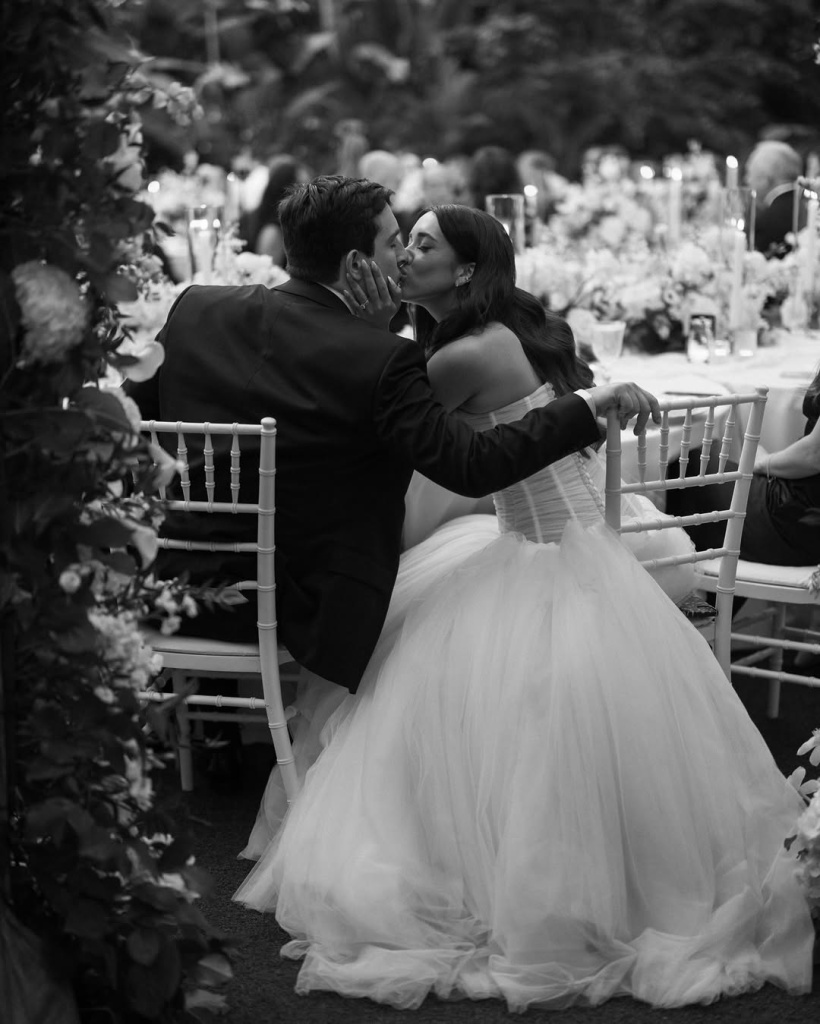
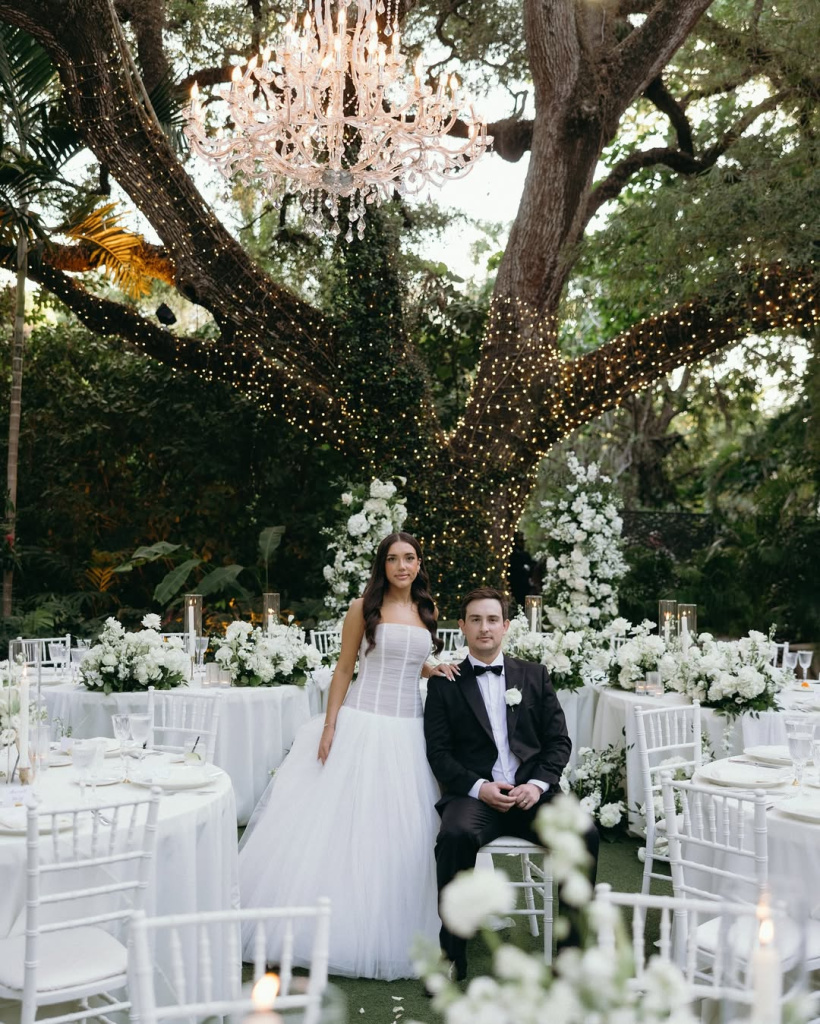
No two wedding receptions follow the exact same script, but most include a series of “anchor points” that shape the flow. How you order these moments can influence the overall energy in the room:
- Grand Entrance: A high-spirited way to announce that the newlyweds (and perhaps the wedding party) have arrived.
- First Dance: Typically happens soon after your arrival, setting a romantic tone right away.
- Dinner or Food Service: Whether you opt for plated courses or a casual buffet, let guests know when they can start eating.
- Toasts & Speeches: Best Man, Maid of Honor, parents, or other loved ones may want to speak. Encourage them to keep it heartfelt and brief.
- Cake Cutting: Often a symbolic moment, it also signals that desserts are officially on the horizon.
- Open Dancing or Activities: The party really ramps up here, so have your DJ or band ready to keep the momentum going.
It’s perfectly fine to shuffle these around or skip certain elements altogether, as long as the sequence feels natural to you and your partner.
Food, Drink & Toasts


Eating and drinking are highlights of almost any reception, but it’s easy for small missteps to throw off the atmosphere. Provide clear signage if you have multiple food stations, and let vegetarian, vegan, or gluten-free guests know where they can find dishes that suit their needs. When it comes to alcohol, consider offering both non-alcoholic and lower-proof options. Not everyone wants a heavy pour, especially if they’re driving home or have early obligations the next day.
Toasts often blend laughter and genuine sentiment, but they can quickly overstay their welcome if multiple people speak without a plan. A simple way to keep things flowing is to limit the formal toasts to just a few individuals—usually the Best Man and Maid of Honor, plus any parents who wish to say a few words. You’re free to invite others to speak, but try to keep the total number of speeches to a comfortable minimum. That way, no one is secretly longing for the dance floor while a distant relative goes on and on.
Keeping Guests Engaged
The reception is your big post-ceremony party, so make sure your guests have reason to stay and celebrate. Good music is a staple, whether it’s a live band belting out classics or a DJ spinning crowd-pleasers. If dancing isn’t everyone’s cup of tea, consider adding interactive elements like a photo booth, a candy bar, or a unique guest book station. Garden games—think cornhole or giant Jenga—are a hit at outdoor events, giving those who’d rather chat than dance a fun way to connect.
A few extra ideas:
- Offer light refreshments after a few hours, especially if the festivities stretch late into the evening. A coffee or snack station can be a welcome pick-me-up.
- Make sure older guests or those with mobility challenges have comfortable seating options away from the speakers and dance floor.
- Keep personal touches on display, from family photos to a quirky keepsake table, so people can get a sense of who you and your partner are beyond the formalities of the wedding day.




Gift Etiquette
Gift-giving around weddings can sometimes feel like walking on eggshells—after all, you don’t want to seem greedy, but you also don’t want to leave your guests wondering what you need. This balancing act involves a bit of open communication, some tact, and a healthy dash of gratitude. Proper gift etiquette not only guides you on how to share your preferences but also helps guests feel at ease when choosing something special for your newlywed life.
Setting Up the Registry
A wedding registry can be your best friend when it comes to clarifying what you actually need (and avoiding ending up with six identical toasters). Whether you’re dreaming of high-end kitchen gadgets or hoping to upgrade your bedding, the registry is a polite way to share your wish list.
- Picking Stores & Platforms: Many couples opt for multiple registries—maybe one at a department store, another at a home improvement retailer, or even a honeymoon fund online. Think about the variety of items you’d like and pick platforms that reflect your tastes.
- Balancing Price Points: Include items with a wide range of costs so guests can choose something that fits their budget. Not everyone can splurge on the most expensive cookware set, and that’s okay.
- Informing Guests: The best way to direct people to your registry is through word of mouth, a small enclosure in the invitation envelope, or a link on your wedding website. It’s generally considered impolite to list your registry directly on the main invitation.
Managing Monetary Gifts & Alternatives
In modern weddings, it’s more common than ever for couples to politely request monetary gifts—maybe you’re saving for a down payment on a house, or you’d rather invest in experiences than kitchenware. Be clear yet gracious when mentioning this, but always emphasize that any gift, or even just the guest’s presence, is what truly counts.
Consider these points if you’d like financial contributions:
- Honeyfunds or Cash Registries: Online platforms let guests gift money with an explanation of how it will be used (like “Romantic Dinner in Paris” or “Skydiving Over the Grand Canyon”). This can make the giving process feel more personal.
- Traditional Cash Gifts: Some guests prefer to slip a check into a wedding card. Make sure you have a discreet, labeled box or table at the reception if you expect monetary gifts on the day.
- Charitable Donations: If you want to keep it minimal for yourselves, you can suggest that guests donate to a favorite charity in lieu of gifts.
Receiving, Opening & Acknowledging
The way you receive and acknowledge gifts can leave a lasting impression on your guests. It’s a chance to show genuine gratitude for the thought, time, and expense they put into celebrating with you.
- Opening Gifts: Some couples open gifts as they receive them, others wait until after the wedding. If your gathering is quite large, it might be best to open in private later rather than making guests sit through a marathon unwrapping session at the reception. Smaller events, like a shower or post-wedding brunch, can be more conducive to opening presents in front of everyone.
- Thank-You Notes: Aim to send a handwritten or personalized digital note within three months of the wedding. Mention the specific gift and how you plan to use it—or, if it’s cash, share a little about what you’ll be putting it toward. This thoughtful detail shows genuine appreciation and lets the giver feel connected to your future plans.
- Logging & Tracking: Keep a running list of who gave what. It might not be romantic, but it’s essential for ensuring no one’s overlooked once you start writing those thank-yous.
By handling the gift-giving side of your wedding with grace and a clear sense of your needs, you’ll keep your guests well-informed and comfortable—and they’ll appreciate knowing exactly how to support you as you embark on this new chapter together. After all, the real essence of gift etiquette comes down to gratitude and respect: letting the people in your life know you recognize and value their generosity, whether it arrives in the form of a physical present, a check, or a simple but heartfelt “Congratulations.”





Post-Wedding Etiquette
Once the cake is cut and the final toast has been made, you might feel like your wedding checklist has finally been completed. But the truth is, a few key tasks and thoughtful gestures remain after you’ve said your vows and danced the night away. In many ways, these follow-up steps can be just as meaningful as all the planning you did beforehand.
Savoring the Afterglow
The days (and even weeks) following your wedding can be a blur of happiness and relief. It’s a whirlwind of replaying your favorite moments, flipping through candid photos, and rehashing every detail with anyone who will listen. While it’s tempting to drop everything and jump straight into your honeymoon or “normal” life, taking a moment to soak it all in can be incredibly grounding.
- Pause and reflect on the day itself—what went beautifully, which moments surprised you, and how it all felt in the moment.
- If you have a digital wedding album or social media hashtags, spend an evening scrolling through those snapshots together, perhaps over a glass of wine.
- Share a casual post or update with friends and family who couldn’t attend, letting them know how much they were missed.
By allowing yourselves this reflective space, you’ll solidify the wedding’s significance in your memory before the rest of life starts crowding back in.
Writing Thank-You Notes
Thank-you notes are the lifeblood of post-wedding etiquette, offering a personal, heartfelt acknowledgment of the love and support your guests brought to your celebration. It’s not just about checking a box; it’s an opportunity to connect with each person who stood by you or sent well-wishes.
Begin the process by gathering a list of everyone who gave you gifts or shared in your day, making a quick note of what they did or contributed—was it a physical gift, a monetary donation, or perhaps the special talent of singing at your ceremony? Then, start tackling your notes in smaller batches, so you’re not overwhelmed. The key is sincerity. Mention details about the gift and how you plan to use it, or reminisce about a sweet moment you shared during the reception. Even a line or two of genuine warmth can make someone’s day and show them you truly noticed their contribution.
Tying Up Loose Ends
Weddings can leave a surprising amount of administrative follow-up in their wake. Perhaps you need to confirm final payments with vendors, return rented table linens, or settle any outstanding balances for catering. These details might not be glamorous, but they help cement your good relationships with the professionals who made your day run smoothly.
Another aspect of winding down is leaving honest reviews for vendors. Whether they went above and beyond or simply did the job as promised, a considerate review (or direct feedback if there were hiccups) can help them grow their business and better serve future couples. And if you had vendors who felt more like partners than just service providers, a thank-you gift or token of appreciation can go a long way toward expressing genuine gratitude.
Ultimately, post-wedding etiquette is a gentle reminder that the spirit of your celebration doesn’t end when you leave the venue. By taking the time to truly relish what you’ve just experienced, properly thank those who helped, and tie up any outstanding odds and ends, you’ll glide into married life free from loose ends—and full of the same kind of warmth that made your wedding day so special in the first place.







